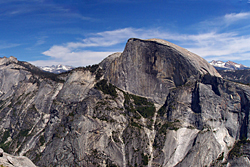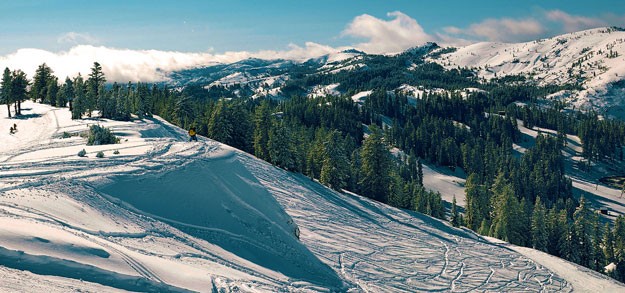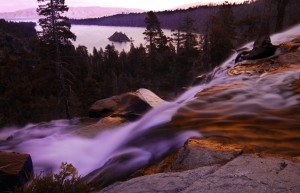- Tahoe’s Nevada Beach Tops the List of Hard-to-Book Campgrounds - 07/17/2024
- Cannabis Watershed Protection Program Cleans Up Illegal Grow Sites - 07/10/2024
- French Fire - 07/05/2024
By John Yewell
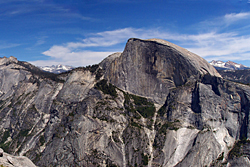
The stunning northwest face of Half Dome.
Photo: Karl Bralich
When it came time to design its state quarter for the U.S. Mint, California had a wealth of iconic images from which to choose: larger-than-life personalities, grand structures (the Golden Gate Bridge would have been an obvious choice), and countless natural wonders. In the end, a state not known for dwelling on the past did just that, reaching deep into history to create an illustration with a strong conservation theme depicting the ancient California condor, the great naturalist John Muir, and Yosemite’s 87 million year old Half Dome.
And there’s a million-year-old message hidden inadvertently in the coin’s design. Muir long ago achieved a kind of sainthood, and the condor is undergoing a captive breeding program that has rescued it from the brink of extinction. It’s time that Half Dome, under pressure from a crush of visitors, be redeemed as well. Yosemite was Muir’s cathedral, after all, and Half Dome was its altar, courtesy of George Anderson.
Anderson was a Scottish blacksmith who first climbed Half Dome in 1875 by the route now leading to, and occupied by, the famous steel cables.
He hauled a forge to the base and made eyebolts into which he inserted lengths of rope, creating a series of grips. Anderson wasn’t motivated purely by a desire to be first to the top. According to some accounts, the first person to the top, regarded by many at the time as the only insurmountable summit in the valley, would earn the right to build a hotel at Half Dome’s foot.
Anderson initiated the use of climbing hardware in Yosemite, and his remained on Half Dome for 35 years. In 1910, the Sierra Club removed them and stretched a single cable down Half Dome’s flank in their place. Hoping to increase tourism, Camp Curry’s David Curry urged the Sierra Club to construct an even easier method of ascent, and thus was born in 1919 the current double cable, stanchion and two-by-four plank system. At the same time granite steps, sometimes referred to as the Devil’s Staircase, were built into the lower dome leading up to the saddle at the base of the cables.
I was 17 in 1971 when my cousin Roy and I first climbed Half Dome at the end of a backpacking trip from June Lake. A photo from that trek shows us alone on the cables — a virtual impossibility today. Certainly by that year Yosemite Valley was already overcrowded, but the masses had not yet discovered the Half Dome trail.
I’ve been up a dozen times since, and try to go every summer as a kind of pilgrimage. But last summer, after years of increasingly rude behavior from the growing swarm of hikers, I finally hit a wall.
I was about halfway up the cables when a teenager at the bottom with a mini boom box insisted on sharing his music. I shouted, asking him to shut it off, and he shouted something back, but the music continued. I practically ran up the rest of the way to escape. I didn’t fault him. His adult supervisors were the real problem, having apparently made little effort to instill in him any respect for the outdoors.
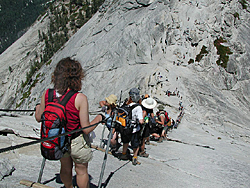
Heading down the cable route.
Photo: John Wang,
At the summit people weren’t much better behaved, shrieking, running around, and talking on cell phones. The adults were as bad as the teenagers. I’m usually better at ignoring Yosemite’s crowds, but this time I swore it was my last trip. I admit to a certain sensitivity on the subject. I adopted Muir’s cathedral as my own in 1962, when I was eight.
But every summer my reverence for the place gets harder to sustain, as an increasing number of hikers — the Park Service last estimated the number at 400 a day in 1994 — makes the roughly 17-mile round trip up Half Dome. They are suffocating what used to be a wilderness experience, not to mention damaging plant and wild life — most notably the Mt. Lyell salamander, and the trees, now virtually gone, on the summit.
The Park Service says it promotes the “leave no trace”principle, which has had some success at minimizing damage to the environment. But its passive education effort has left almost entirely unaddressed the broader issue of trail courtesy and noise pollution. The Park Service seems reluctant to confront the issue head-on, but cell phones and even loud iPods can be more disruptive to the wilderness experience than a discarded beer can.
The NPS is missing an opportunity. Because the Half Dome trail is the first wilderness experience for many hikers, it is an ideal place to teach backcountry etiquette Å0ç0 if we can summon the will and resources to do so. The Park Service should take advantage of that allure and undertake a vigorous education program. A simple start would be a sign at Happy Isles, at the beginning of the trail, with suggestions for how to assure a wilderness experience for everyone (see sidebar).
The alternative may be extending the quota system, now used exclusively for overnight backcountry use, to the day-use portion of the trail beyond the top of Nevada Falls. Continuing to ignore the problem is not an option. All it takes is paying more attention to the rock itself, which has created its own inspiring icons — like a diminutive 70-plus year old named Ruth I met a few years ago on the trail. Ruth practically sprinted to the cables, then scampered up the 800-foot, 45-degree incline as a group of high school football players watched from the lower dome, begging off for fear of heights.
That’s Half Dome’s trump card: the climb remains daunting for many, otherwise trail use would be even greater. For that reason and many others, I’m not among those who argue for removing the cables. But if something isn’t done about the environmental degradation and trail behavior, the voices of those who advocate removing the cables will grow stronger.
The pull of Half Dome remains strong, and it wasn’t long before I began to rethink my oath. The things that bring me back are the things that will never change: the feel of steep granite under my boots; the quality of the air and light; the smell of the forest; and most of all, of course, the view. Whenever I want a reminder, I can reach into my pocket and pull out a quarter.
I don’t expect a return to the serenity of Anderson’s 1875 Half Dome, but the rest of his story does contain a portentous note. Soon after reaching the summit, and before he had time to give his hotel much thought, Anderson set about replacing his crude grips with a ladder. Before he could finish, he became sick and died. Perhaps Half Dome was offering him, and us, a lesson in the pitfalls of easy access.
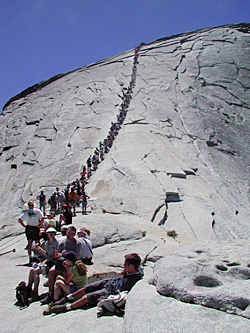
Photo: John Wang
Half Dome —Trail Etiquette
Noise
If the music of granite and water don’t seduce you, the least you can do is not ruin it for others. If you must take your iPod, remember that on the trail even headphones can be overheard by people nearby. Bring a boom box, go to jail. Unless you’re falling to your death, don’t scream or talk above a conversational level. With so many hikers you’re rarely alone, even on Half Dome’s 10-acre summit.
Cell Phones
Seventy percent of respondents to a 2003 online poll by nwhikers.net said cell phones should be taken into the wilderness for emergency use only. Another 19 percent said they don’t belong there at all. Pack it if you must, but keep it turned off. Coverage is spotty, but calling your girlfriend or buddy from the summit to say “You’ll never guess where I’m calling you from!” is strictly déclassé.
Cable traffic
People climb and descend at different rates, so be considerate of the pace, and fears, of others. Whether you stay between the cables or go outside, never disturb another climber’s grip, and offer assistance to those suffering from fatigue or acrophobia.
Gloves
At the bottom of the cables is a pile of gloves, which will improve your grip on the hot, slippery steel. Most are worn out and only nominally useful. Better to bring your own and leave them for others when you’re done. Inexpensive cloth garden gloves with small rubber studs on the palms and fingers grip better than leather.
2005 Summer —Trail Restrictions
The Park Service plans to close the steps on the lower dome for repairs Monday through Thursday from 7 A.M. to 4 P.M., from July 6 to Oct. 4.
Access to the summit will be blocked during those times, resulting in more concentrated trail use on the remaining three days of the week.
Get an early start. The cables are going to be even more crowded than usual.

